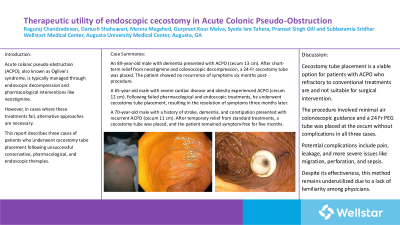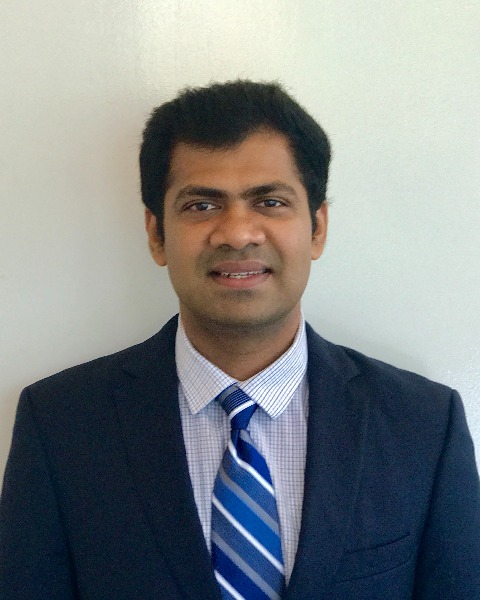Monday Poster Session
Category: Interventional Endoscopy
P2818 - Therapeutic Utility of Endoscopic Cecostomy in Acute Colonic Pseudo-Obstruction
Monday, October 28, 2024
10:30 AM - 4:00 PM ET
Location: Exhibit Hall E

Has Audio

Raguraj Chandradevan, MBBS
Medical College of Georgia at Augusta University
Augusta, GA
Presenting Author(s)
Award: Presidential Poster Award
Raguraj Chandradevan, MBBS1, Dariush Shahsavari, MD2, Amit Hudgi, MD2, Menna Megahed, MD3, Gurpreet Kaur, MD1, Harshitha Addagatla, MD4, Subbaramiah Sridhar, MBBS, MPH2
1Medical College of Georgia at Augusta University, Augusta, GA; 2Augusta University, Augusta, GA; 3Augusta, GA; 4Augusta University Medical Center, Augusta, GA
Introduction: Endoscopic decompression & neostigmine are currently the available treatment options for colonic pseudo-obstruction (ACPO; Ogilvie’s syndrome). Here we describe three patients presented within last two years underwent cecostomy tube after failing conservative medical, pharmacological & endoscopic therapy.
Case Description/Methods: Patient A:
An 89-year-old male with dementia was admitted with Ogilvie syndrome (cecum 13cm). He received 2 doses of neostigmine twice and 2 colonoscopies for decompression. They provided a short-term relief for 48 hours & distention recurred. A 24-Fr cecostomy tube was placed endoscopically. He was discharged to the nursing home with instructions for post cecostomy care. Six mts following the cecostomy he continues to do well with no recurrence in the abdominal distension.
Patient B:
A 65-year-old male with severe cardiac disease, obesity was admitted with Ogilvie’s syndrome (cecum 12 cm). The patient failed 2 neostigmine and 2 endoscopic decompressions. He subsequently underwent cecostomy tube placement. He was discharged home with post-cecostomy care. He remains well with no recurrence of abdominal distension 3 mts following cecostomy.
Patient C:
A 70-year-old male with history of disabling stroke, constipation, dementia presented with recurrent Ogilvie’s syndrome (cecum11 cm). He received 2 neostigmine & endoscopic decompressions with temporary relief. He was re-admitted in a week with distention. An endoscopic cecostomy tube placement was placed, and the patient was discharged home with post-procedure cecostomy care. The patient remains well 5 mts following the cecostomy.
Discussion: Cecostomy tube placement should be considered in patients who are refractory to conservative, pharmacologic & endoscopic decompression, especially those not amenable to surgical intervention. All our patients received two days of bowel prep., 3 days of antibiotics pre and 3 days following the procedure. The procedures were performed with patient in supine position. The adult colonoscope was advanced to cecum with minimal air, after reaching the cecum, with proper transillumination a 24-Fr PEG tube was placed similar to the gastric PEG tube placement. None of our patients had complications. Common complications observed are pain, leakage, and buried bumper and severe complications were migration, perforation, and sepsis. Physicians are unfamiliar with this relatively safe and effective option for managing acute colonic pseudo-obstruction.
Disclosures:
Raguraj Chandradevan, MBBS1, Dariush Shahsavari, MD2, Amit Hudgi, MD2, Menna Megahed, MD3, Gurpreet Kaur, MD1, Harshitha Addagatla, MD4, Subbaramiah Sridhar, MBBS, MPH2. P2818 - Therapeutic Utility of Endoscopic Cecostomy in Acute Colonic Pseudo-Obstruction, ACG 2024 Annual Scientific Meeting Abstracts. Philadelphia, PA: American College of Gastroenterology.
Raguraj Chandradevan, MBBS1, Dariush Shahsavari, MD2, Amit Hudgi, MD2, Menna Megahed, MD3, Gurpreet Kaur, MD1, Harshitha Addagatla, MD4, Subbaramiah Sridhar, MBBS, MPH2
1Medical College of Georgia at Augusta University, Augusta, GA; 2Augusta University, Augusta, GA; 3Augusta, GA; 4Augusta University Medical Center, Augusta, GA
Introduction: Endoscopic decompression & neostigmine are currently the available treatment options for colonic pseudo-obstruction (ACPO; Ogilvie’s syndrome). Here we describe three patients presented within last two years underwent cecostomy tube after failing conservative medical, pharmacological & endoscopic therapy.
Case Description/Methods: Patient A:
An 89-year-old male with dementia was admitted with Ogilvie syndrome (cecum 13cm). He received 2 doses of neostigmine twice and 2 colonoscopies for decompression. They provided a short-term relief for 48 hours & distention recurred. A 24-Fr cecostomy tube was placed endoscopically. He was discharged to the nursing home with instructions for post cecostomy care. Six mts following the cecostomy he continues to do well with no recurrence in the abdominal distension.
Patient B:
A 65-year-old male with severe cardiac disease, obesity was admitted with Ogilvie’s syndrome (cecum 12 cm). The patient failed 2 neostigmine and 2 endoscopic decompressions. He subsequently underwent cecostomy tube placement. He was discharged home with post-cecostomy care. He remains well with no recurrence of abdominal distension 3 mts following cecostomy.
Patient C:
A 70-year-old male with history of disabling stroke, constipation, dementia presented with recurrent Ogilvie’s syndrome (cecum11 cm). He received 2 neostigmine & endoscopic decompressions with temporary relief. He was re-admitted in a week with distention. An endoscopic cecostomy tube placement was placed, and the patient was discharged home with post-procedure cecostomy care. The patient remains well 5 mts following the cecostomy.
Discussion: Cecostomy tube placement should be considered in patients who are refractory to conservative, pharmacologic & endoscopic decompression, especially those not amenable to surgical intervention. All our patients received two days of bowel prep., 3 days of antibiotics pre and 3 days following the procedure. The procedures were performed with patient in supine position. The adult colonoscope was advanced to cecum with minimal air, after reaching the cecum, with proper transillumination a 24-Fr PEG tube was placed similar to the gastric PEG tube placement. None of our patients had complications. Common complications observed are pain, leakage, and buried bumper and severe complications were migration, perforation, and sepsis. Physicians are unfamiliar with this relatively safe and effective option for managing acute colonic pseudo-obstruction.
Disclosures:
Raguraj Chandradevan indicated no relevant financial relationships.
Dariush Shahsavari indicated no relevant financial relationships.
Amit Hudgi indicated no relevant financial relationships.
Menna Megahed indicated no relevant financial relationships.
Gurpreet Kaur indicated no relevant financial relationships.
Harshitha Addagatla indicated no relevant financial relationships.
Subbaramiah Sridhar indicated no relevant financial relationships.
Raguraj Chandradevan, MBBS1, Dariush Shahsavari, MD2, Amit Hudgi, MD2, Menna Megahed, MD3, Gurpreet Kaur, MD1, Harshitha Addagatla, MD4, Subbaramiah Sridhar, MBBS, MPH2. P2818 - Therapeutic Utility of Endoscopic Cecostomy in Acute Colonic Pseudo-Obstruction, ACG 2024 Annual Scientific Meeting Abstracts. Philadelphia, PA: American College of Gastroenterology.

